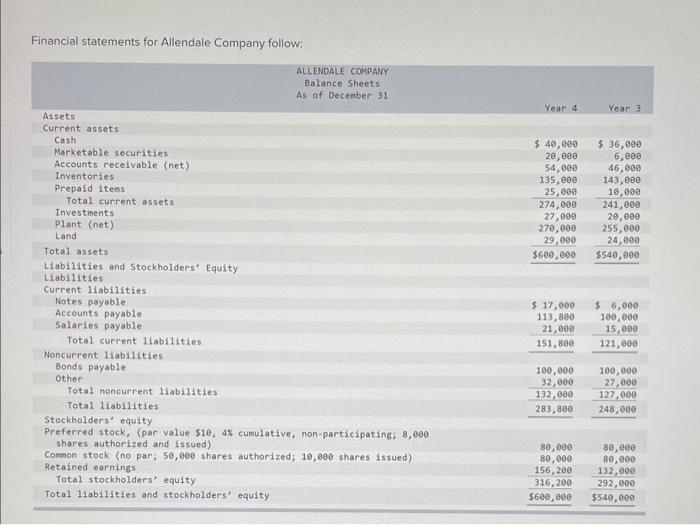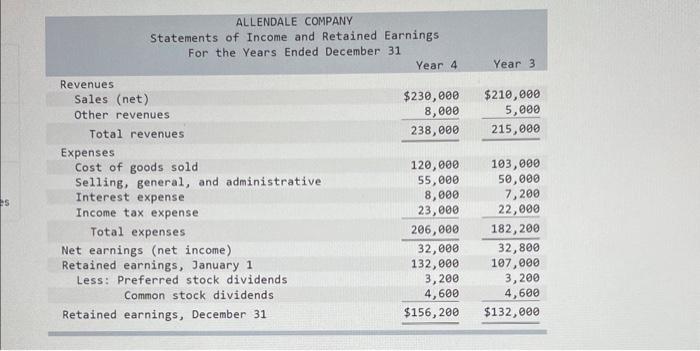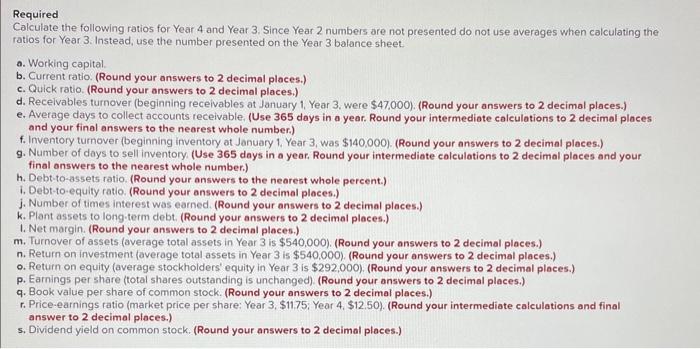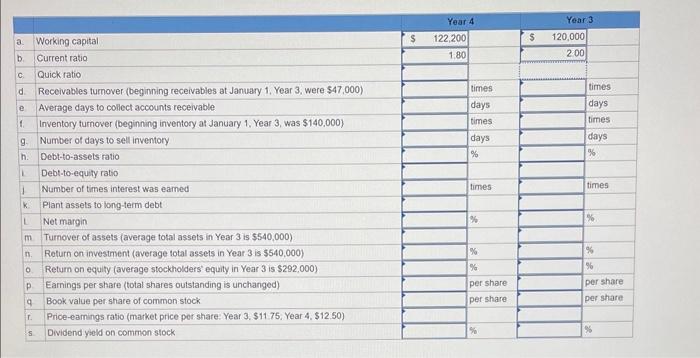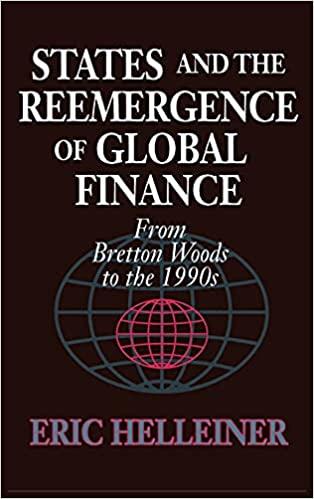Financial statements for Allendale Company follow: ALLENDALE COMPANY Balance Sheets As of Decenber 31 Assets Year 4 Year 3 Current assets Cash. Marketable securities Accounts receivable (net) Inventories Prepaid itens Total current assets Investiments Plant (net) Land Total assets Liabilities and Stockholders' Equity Liabilifies Current liabilities Notes payable Accounts payable Salaries payable Total current liabilities Noncurrent liabilities. Bonds payable other Total noncurrent liabilifies Totol liabilities Stockholders' equity Preferred stock, (par value $10,4% cumulative, non-participating; 8,600 shares authorized and issued) Common stock (no par; 50, e shares authorized; 10, 060 shares issued) Retained earnings Total stockholders' equity Total 11abilities and stockholders' equity ALLENDALE COMPANY Statements of Income and Retained Earnings For the Years Ended December 31 \begin{tabular}{lrrr} Revenues & & \\ Sales (net) & $230,000 & $210,000 \\ Other revenues & 8,000 & 5,000 \\ Total revenues & 238,000 & 215,000 \\ \cline { 2 - 4 } Expenses & & \\ Cost of goods sold & 120,000 & 103,000 \\ Selling, general, and administrative & 55,000 & 50,000 \\ Interest expense & 8,000 & 7,200 \\ Income tax expense & 23,000 & 22,000 \\ Total expenses & 206,000 & 182,200 \\ Net earnings (net income) & 32,000 & 32,800 \\ Retained earnings, January 1 & 132,000 & 107,000 \\ Less: Preferred stock dividends & 3,200 & 3,200 \\ Common stock dividends & 4,600 & 4,600 \\ \hline Retained earnings, December 31 & $156,200 & $132,000 \\ \hline \end{tabular} Required Calculate the following ratios for Year 4 and Year 3. Since Year 2 numbers are not presented do not use averages when calculating the ratios for Year 3 . Instead, use the number presented on the Year 3 balance sheet. a. Working capital. b. Current ratio. (Round your answers to 2 decimal places.) c. Quick ratio. (Round your answers to 2 decimal places.) d. Recelvables turnover (beginning receivables at January 1, Year 3, were $47,000 ). (Round your answers to 2 decimal places.) e. Average days to collect accounts receivable, (Use 365 days in a year. Round your intermediate calculations to 2 decimal places and your final answers to the nearest whole number.) f. Inventory turnover (beginning inventory at January 1. Year 3, was $140,000 ). (Round your answers to 2 decimal places.) 9. Number of days to sell inventory. (Use 365 days in a year. Round your intermediate calculations to 2 decimal places and your final answers to the nearest whole number.) h. Debt-to-assets ratio. (Round your answers to the nearest whole percent.) i. Debt-to-equity ratio. (Round your answers to 2 decimal ploces.) j. Number of times interest was earned. (Round your answers to 2 decimal places.) k. Plant assets to long-term debt. (Round your answers to 2 decimal places.) 1. Net margin. (Round your answers to 2 decimal places.) m. Turnover of assets (average total assets in Year 3 is $540,000 ). (Round your answers to 2 decimal places.) n. Return on investment (average total assets in Year 3 is $540,000 ). (Round your answers to 2 decimal places.) o. Return on equity (average stockholders' equity in Year 3 is $292,000 ). (Round your answers to 2 decimal places.) p. Earnings per share (total shares outstanding is unchanged). (Round your answers to 2 decimal places.) q. Book value per share of common stock. (Round your answers to 2 decimal places.) r. Price-earnings ratio (market price per share: Year 3, \$11.75: Year 4, \$12.50). (Round your intermediate calculations and final answer to 2 decimal places.) s. Dividend yield on common stock. (Round your answers to 2 decimal places.)
